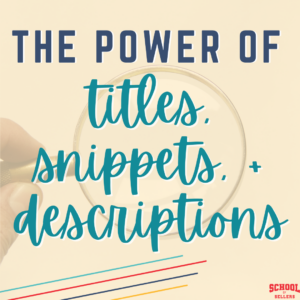Have you ever struggled to come up with TeachersPayTeachers product ideas for your store? Maybe you’re just in a creativity slump and are looking for new inspiration for TpT products. Or maybe you’re no longer in the classroom and find that your best source of ideas (your students!) just isn’t an option anymore. No matter the cause, welcome to the club! Many of us struggle with deciding what to make, so this post will provide several ideas to help get your creativity flowing.

So where can you find inspiration for TeachersPayTeachers product ideas?
Sorry to go all Hallmark Christmas movie on you and stuff, but the best answer has probably been inside you all along. Much like the somewhat handsome, big city stranger that recently invaded your small town to build a ski resort or something, you just need to dig a little deeper to find what you’re looking for. So here are some reflection questions you can ask yourself to get started.
1. What can I learn from my own classroom?
We’re starting here because our own classrooms (or other educational settings) make the most sense when it comes to finding inspiration for TeachersPayTeachers product ideas. Think about activities you’re currently using or have used in the past. What works for you? What do your students need? Which activities do your students like and beg to do again? Which topics do you find the most compelling? Is there anything you wish you had? Do a quick reflection on your time in the classroom, no matter if you’re still there or not. If you were never a traditional classroom teacher, you can still think about all of those years you spent in the classroom as a student.
2. What do I enjoy making?
This question is really important to me personally because enjoying what I’m doing is a crucial factor when it comes to staying motivated. If I’m making TpT resources that I’m not passionate about, I tend to either rush through them or not finish them at all, and that doesn’t do anyone any good. So now I try to focus on topics I love teaching or learning about myself. Write down some of your favorite products you’ve already created, regardless of how well they’ve sold. What did you like about making them?
3. What am I good at making? What are my best sellers on TpT?
This may seem similar to the first question, but what you enjoy doing does not always directly relate to what you’re good at doing. How do you know what you’re good at making? Your best selling resources are a great place to start. First, look at your top five best-selling products on TpT. Taking them as a group, do you notice anything they have in common such as the format, how the products are used, what grade level(s) and subject area(s) they fit, content and skills being taught, etc.?
Once you’ve identified a few of your best-selling resources’ most important characteristics, use your list to generate some ideas of similar products you could create. As you do this, also consider ways to reformat your best-selling resources in new ways. For example, could a popular game be turned into a center or station activity with some minor tweaking? Could something like a set of vocabulary flash cards easily be turned into word wall posters on the same topic? Not only are these new ideas for your store, but they’re time saving ones too since you’re re-purposing content you already have.
4. What do teachers in my subject area/grade level not have time to create or just don’t want to?
Just because you’re good at making something or really enjoy it doesn’t mean other people want it, so this question of what your audience needs and wants is an important one. Think specifically about the teachers in your niche. How can you save them time? A great way to find out exactly what teachers are looking for is to join teacher Facebook groups. Spend some time browsing posts and see what questions teachers are asking, what topics they’re having a hard time finding resources for, and what they’re struggling with. I discuss this idea a little more in depth below.

5. What activities do my students really engage with? What do they enjoy about them?
Our students can be some of our biggest critics, but they also tend to let us know when they enjoy a particular activity. Think about anything you’ve used in your classroom that students especially enjoyed or that they asked to do again. Chances are other students will love them too! You may also want to think about activities you enjoyed as a student. What were they and what did you like about them?
6. What are other people telling me? Which resources do people really seem to like, even if they aren’t my best sellers?
Sometimes our best products are not necessarily our best-sellers. So it’s important to look at other data too. Make it a habit to regularly reflect on what other people are saying about your work. Do your colleagues come to you for particular resources? What are customers saying in your TpT feedback, Q&A, and in any personal requests you’ve received? Listen to your customers and your loyal fans!
7. What’s happening now or will happen soon that can be adapted to create learning resources?
It’s important to stay current with trends, both inside your classroom and out. Take a few minutes to think about current events, trends, and pop culture topics that are especially popular right now or seem to be gaining steam. These can be great sources of inspiration!
Other Sources of Inspiration for TeachersPayTeachers Product Ideas
In addition to asking yourself the questions above, it’s also important to look for inspiration all around you. Here are a few more ways to help you come up with TeachersPayTeachers product ideas for your store:
Shop for some clip art or stock photos
Browse sites like TpT, Etsy, or wherever else you get your design elements for your resources. Sometimes just seeing some really cute or creative clip art can inspire several new ideas. Please don’t just buy every cute set you see though! I have a rule that I can’t buy any clip art unless I can name 3-5 products that it could be used for. I feel like it has saved me a lot of money and helps me be more intentional about my business expenses.
Stop by your local Dollar Tree, Hobby Lobby, Target, etc.
Chances are you’ve already given these places a fair share of your income, so why not let them give back? Instead of walking in with the intention of buying anything, walk in with a notebook instead. When something catches your eye, take a minute to brainstorm ideas for how it could be used to support learning. What resources could you create that relate to or support your ideas?
Join teacher Facebook groups
Social media is a great way to get a sense of what teachers are looking for, struggling with, or just thinking about. Social studies is my main niche, so I keep up with groups dedicated to social studies teaching in general, elementary social studies, middle school social studies, and specific social studies courses like AP Human Geography. I don’t usually create products for all of these audiences, but sometimes seeing a question in the elementary group can inspire me to create a related middle school resource. In addition to content areas, consider groups for particular grade levels, geographic regions, student populations (ELL, gifted, etc.), and settings (homeschool, private/charter, religious, etc.).
Ask your audience
Sometimes the best way to know what resources you should be creating is to just ask. Use social media, a poll, or your email list to gather information about what teachers are struggling with and the resources they wish they had.
Revisit the standards
Standards are actually one of my favorite sources of inspiration. Not only do they list topics teachers are guaranteed to be teaching, but they can also be used to help sell your products. Administrators often check to make sure TpT resources are aligned to standards before they approve their purchase. And many teachers use standards to filter their search results on TpT. I recommend focusing on the standards that are used in your local community, but you can always expand beyond those too. TpT allows you to specifically tag Common Core State Standards (CCSS), Next Generation Science Standards (NGSS), Virginia Standards of Learning (VA-SOL), and the Texas Essential Knowledge and Skills (TEKS) standards. If you tag using CCSS, buyers can now see how those translate into their specific state standards using the TpT standards crosswalking feature.
Engage in professional development
PD sessions are a great source of inspiration for new products because they keep you up to date with the latest trends and research in the field of education. If you no longer have access to professional development, you can always engage in your own by listening to podcasts, reading educational books, following teaching blogs, etc.
Speaking of professional development, don’t forget to engage in professional development for your business too! The School of Sellers podcast is a great place to start, and I also have several recommendations for business books for TpT sellers.
Visit your local library and/or bookstore
I love checking out the children’s area of any bookstore or library I visit. Both do a great job of highlighting popular texts, and the non-fiction areas provide a lot of inspiration too. The children’s non-fiction area is also one of my favorite ways to gain content knowledge. For example, I like to create PowerPoints about individual countries. I can learn a ton of relevant, easy to digest information about particular countries in a short amount of time by reading a children’s book on the topic.
Spend time around kids
Even if you’re no longer in the classroom and don’t have children of your own, you can still use kids as a source of inspiration. I make it a habit to regularly ask my nieces and nephews about their favorite activities in school or what they’re learning in social studies throughout the year. Other ways to maintain a connection to schools include substituting, tutoring, and volunteering.
Explore your tagging options on TpT
This one may seem a little weird, but it always seems to work for me. TpT allows you to tag a lot of different subject areas and resource types when you create a new product. Sometimes I just look through the list of available options and see what ideas come to mind. For example, I saw there was a whole category dedicated to DBQs. This inspired me to think about a DBQ I could create that aligns with my niche. If you don’t want to scroll through all of the tagging options in the TpT product editor, you can find them all conveniently listed in our free product creation checklist. Just fill out the form below to download it.
Use the TpT search
Another way to use the TpT website for product inspiration is to track the “Popular Now” search terms. If you hover in the TpT search box before typing anything, you’ll notice a list of 5 popular search terms pops up. I like to track these regularly to get a sense of what people are searching for, and when. The TpT search box is also helpful for inspiration if you have a particular topic in mind. For example, when I start typing the term “fractions” into the box, TpT automatically suggests other searches such as equivalent fractions, adding and subtracting fractions with unlike denominators, comparing fractions, and fractions on a number line. Those terms would be a great place to start for my brainstorming.
Adapt for the holidays
Holiday and seasonal products tend to do very well on TpT. Take a look at your current resources. Which ones could be adapted to include a holiday or seasonal element? For example, one of my best-selling resources is a simple map scale quiz. I used this to create another quiz, but this time with a zombie theme that’s great for Halloween. I wouldn’t create a map scale quiz for every single holiday, but look for opportunities to adapt your existing products to add fun holiday elements.
That’s it! Those are all of my ideas for ways to find inspiration for TeachersPayTeachers product ideas. You have like a million new ideas now, right? I thought so. Have you used any of these tricks yourself? Did I forget any others that you have used successfully in the past? I would love to hear about your experiences as you brainstorm new ideas for your store. In the meantime, remember to hang out with us in the School of Sellers Facebook group, check out the podcast, follow us on the ‘gram, and let us know what questions you have in the comments below.

Let’s connect! Follow us on the podcast, the Facebook group for new sellers, the Facebook group for established sellers, YouTube, Instagram, and TikTok!





